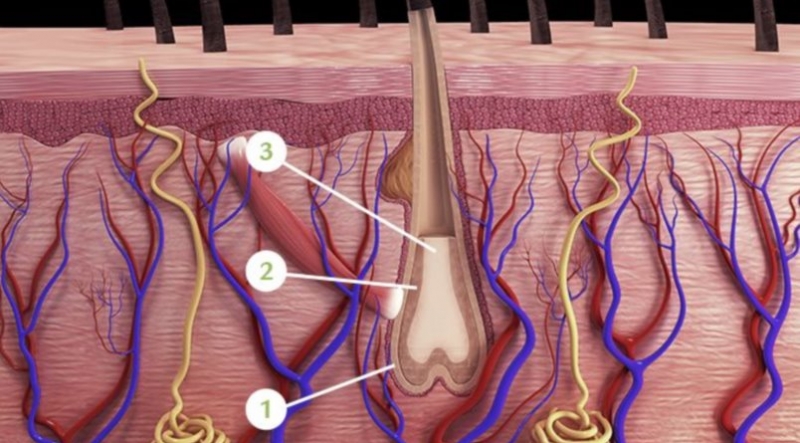
LEARN TO BETTER UNDERSTAND YOUR SCALP AND HAIR
Scalp
The scalp has a protective layer of tissue on the surface, the epidermis, and a nourishing supportive layer of tissue underneath, the dermis, which contains multiple blood vessels where the root of the hair (the follicle) develops an "exchange zone" (dermal papilla) for extracting the vital energy for the hair. Next to the root is a sebaceous gland which secrets sebum to coat the entire length of the hair and protect it.
Hair
The visible part of the hair, the shaft, is made of three layers:
1. External layer (cuticle) formed of protective overlapping scales.
2. Middle layer (cortex) made of keratin fibers grouped together in spindle-like shapes. This layer contains the pigments responsible for the hair's natural color.
3. Inner layer (medulla).
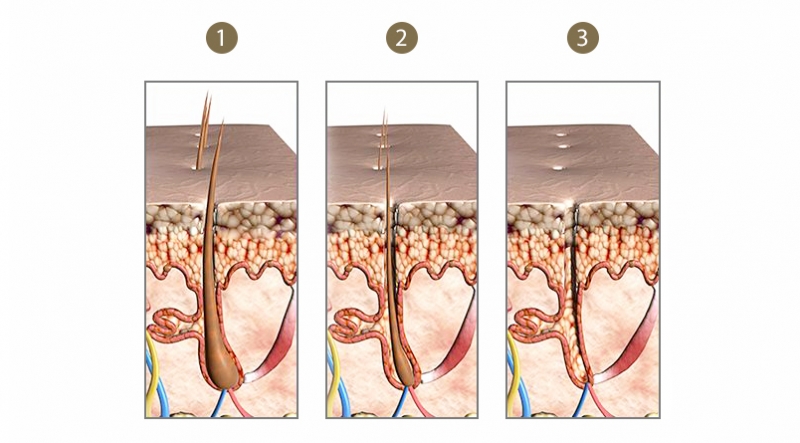
THE HAIR LIFE CYCLE
Our hair is constantly renewing itself. A single hair emerges, grows, then falls out, as part of a hair cycle that repeats itself about 25 times during our lifetime and occurs in three stages:
1. The anagen phase, or growth phase. This lasts about 2 to 3 years in men and 6 to 8 years in women. Under normal conditions, about 85% of our hairs are in the anagen phase. During this phase, the vascular network that supplies the hair root is particularly well-developed around the follicle.
2. The catagen phase, or regression phase, which is fairly brief (2 to 3 weeks), during which the hair follicle becomes inactive. The matrix dies and although the hair does not grow any more, it remains rooted in the follicle.
3. The telogen phase, when the hair is in its rest phase. The hair is shed and replaced by another hair, whereby a new anagen phase begins. This period of renewal lasts approximately 3 months and explains why we normally lose around 100 hairs every day.

THERE ARE 2 TYPES OF HAIR LOSS
GRADUAL HAIR LOSS
This hair loss, also called androgenetic alopecia, is a gradual and localized decrease in the capillary mass. In men, it is found most often at the front and top of the head. In women it is frequently located around the temples and where the hair is parted. When there is partial or complete hair loss, we talk about baldness.
SUDDEN HAIR LOSS
Also called acute diffuse alopecia, it is characterized by a sudden, occasional and massive hair loss, and is generally linked to a particular event (stress, fatigue, emotional shock, dietary deficiency, pregnancy, drug treatments, etc.).

WHAT CAUSES THIS HAIR LOSS?
GRADUAL HAIR LOSS
This is caused by a reduced anagen (growth) phase linked to progressive degeneration of the hair follicles. Each cycle becomes shorter than the one before. Finally, the follicle wears out completely, is reabsorbed, then disappears. The succession of 20 to 25 hair growth cycles, which should last a lifetime, ends sooner than expected.
Gradual hair loss is the result of an often genetic malfunction of the hair follicle in reaction to hormones, leading to premature hair loss. The anagen phase shortens, leading to accelerated and runaway hair cycles, as well as progressive miniaturization of the hair follicles. As a result, the succession of 20 to 25 hair growth cycles, which should last a lifetime, ends sooner than expected, potentially leading to partial or total baldness.
To fight hair loss, we must prolong the lifespan of the hair.
SUDDEN HAIR LOSS
This is caused by a large number of hair follicles entering the telogen (shedding) phase early.
To treat this type of hair loss, you need to QUICKLY REACTIVATE HAIR GROWTH by triggering a new hair cycle.
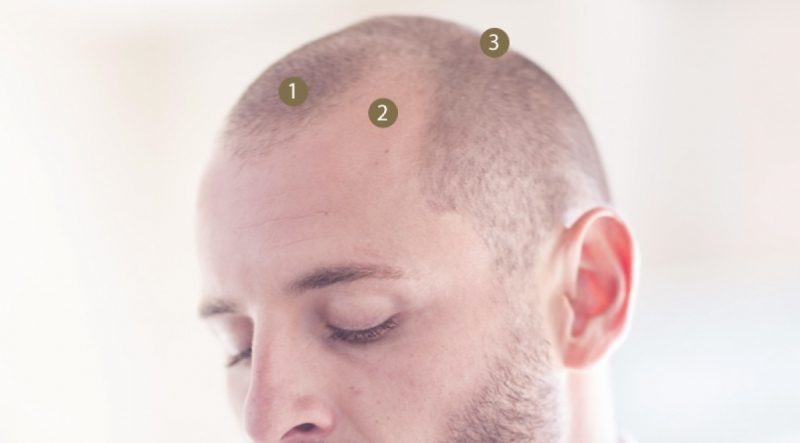
THE CAUSES OF GRADUAL HAIR LOSS
A HORMONE-DEPENDENT DISORDER
Gradual hair loss or alopecia is dependent on certain male hormones, androgens, which are also present in women. This also explains why this phenomenon only begins after puberty.
Gradual hair loss is an abnormal reaction of the hair and scalp to these hormones.
Testosterone is involved in the process, but indirectly. To cause hair loss, it must first be transformed by 5α-reductase into dihydrotestosterone (DHT). The hyperactivity of this enzyme causes an overexpression of DHT.
The overexpression of DHT shortens the hair’s life cycle, resulting in accelerated cycles. The hair production period shortens, the cycles therefore follow on from one another much faster, the hair thins, and the follicle becomes exhausted, dies and disappears.
The other detrimental effect of DHT is that it also damages the hair’s healthy environment. In particular, it stimulates the sebaceous glands, making them produce more sebum.
Combined, these two factors mean that the weakened hairs fall out before reaching maximum length. They are followed by new regrowth, which also has a shortened life span.

THE CAUSES OF SUDDEN HAIR LOSS
POOR CIRCULATION
Growth factors are responsible for increasing the blood flow to the hair follicle. This function is essential to regulating hair growth. Poor circulation to the scalp means the hair bulb does not receive the nutrients it needs and results in hair loss.
THE INFLAMMATORY PATHWAY
Psychological or physical stress or certain disorders will result in an imbalance that will be conveyed as stress at cell level. At the scalp level, cells subject to this stress will release neurotransmitters, including substance P. These neurotransmitters will trigger an acute inflammatory cascade.
An inflammation mediator, TNF-α, is released. This inhibits the hair cycle: hair goes into the telogen phase prematurely. This triggers sudden, rapid hair loss.
NUTRITIONAL DEFICIENCY
Poor circulation and/or certain dietary deficiencies can limit the supply of energy and trace elements to the hair, causing it to enter the telogen (shedding) phase too early.

RENE FURTERER HAIR INNOVATION 2019 INNOVATION: LOTUS MINERAL COMPLEX™
To have an even more comprehensive response and continue to IMPROVE product EFFICACY, we had to find a key ingredient to act on the INFLAMMATORY PATHWAY and combat cellular stress. The LOTUS MINERAL COMPLEX™ has proven its pharmacological efficacy in in-vitro studies : - 60% TNF-α production inhibition*
*In vitro study on the response of epidermal keratinocytes to cellular stress.
Measurement of the amount of TNF-α secreted by the cells following stimulation with Substance P

BIOTRININE : A 360° KEY INGREDIENT
Biotrinine is a new natural-origin key ingredient, obtained by aqueous extraction of the aerial parts of watercress (Nasturtium officinale) and nasturtium (Trapaeolum majus).
It was chosen by René Furterer for its ability to act at each key stage of the life cycle* of the hair in the anagen phase.
Its mode of action:
· Activate the signal necessary for hair growth in the genesis stage
· Stimulate and prolong growth to visibly redensify hair
· Prolong the maturity stage to delay the transition of the hair to the shedding phase and preserve existing hair.
*In-vitro test on the key ingredient.
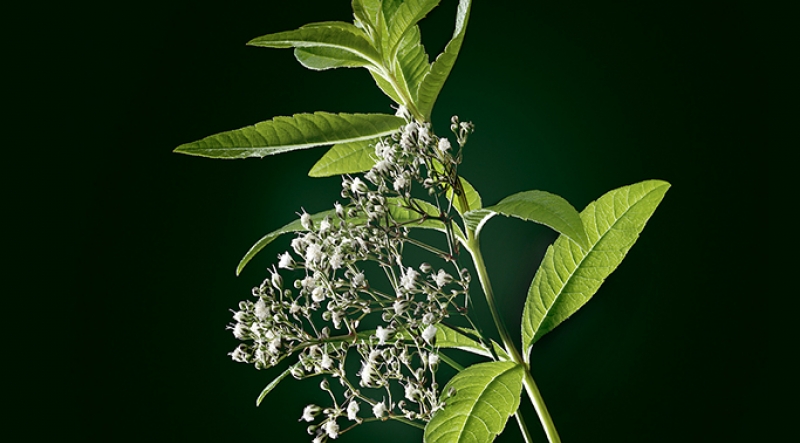
NATURAL PFAFFIA EXTRACT
Native to the Amazon, Pfaffia, also known as Brazilian Ginseng, is undoubtedly the most well-known plant in traditional medicine. Thought to be an elixir of long life, Pfaffia strengthens the internal organs while calming the nervous system and suppressing anxiety. It brings vitality, dynamism and strength.
René Furterer uses the remarkable properties of natural Pfaffia extract*, combined with a scalp massage, to stimulate the microcirculation of the hair bulb. Hair thus receives the nutrients and energy it needs for optimal growth.
This key ingredient is used in every Rene Furterer hair loss product. Going beyond its properties, it benefits from a fair supply chain, "FAIR FOR LIFE." Through this supply chain, René Furterer is committed to improving the standard of living for small producers in the state of Parana in Brazil, all of them certified for organic farming. In addition to its societal and quality commitment, René Furterer helps fight against local deforestation.
*Active tested in vitro

HYDROLYZED CURBICIA EXTRACT (REGISTERED PATENT*)
Curbicia is obtained by hydrolyzing squash seeds, a unique process patented by René Furterer Laboratories. It inhibits the expression of the enzyme that converts testosterone to DHT.
René Furterer uses Hydrolyzed Curbicia extract to reduce excess sebum, since this excess sebum suffocates the hair. The hair bulb is now free to grow.**
*in France
**Shown by a clinical study on the TRIPHASIC PROGRESSIVE finished product.
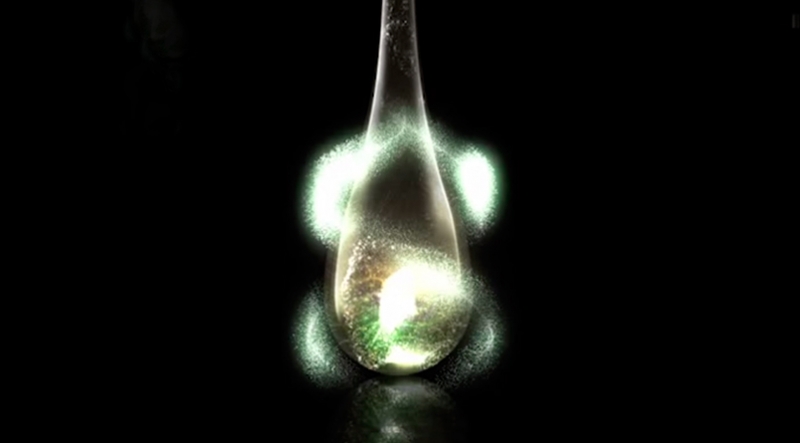
ATP: KEY INGREDIENT INNOVATION
ATP, or Adenosine TriPhosphate, is an active ingredient that is produced naturally by the body. It is an essential source of energy because it is the only fuel that the cells can use directly. Researchers at René Furterer have discovered the incredible effects of ATP on the cells in the hair follicle.
ATP acts right at the heart of the follicle to help maintain the growth (anagen) phase of the hair.
SUITED FOR EVERY TYPE OF HAIR LOSS
ATP:
1. Its triple action at the heart of the dermal papilla extends the life of the hair*, making it a highly effective active ingredient against gradual hair loss.
2. It induces the anagen phase, which makes it possible to rapidly restart hair growth and marks it out as a highly effective key ingredient against sudden hair loss.
This is why René Furterer has included this active ingredient in its two hair loss prevention treatments.
*Active tested in vitro

TO FIND OUT MORE
To find out more about hair loss and the effects of René Furterer care products:
- GRADUAL, HORMONAL, HEREDITARY HAIR LOSS (in men and women):
DermatoMag - The value of Triphasic, a combination of ATP and Biotrinine for the treatment of progressive hair loss - September 2018
- SUDDEN HAIR LOSS (due to stress, diet, illness, after giving birth): DermatoMag - Sudden hair loss. Benefits of RF80 ATP ENERGIE Concentrated serum for hair loss - September 2015






